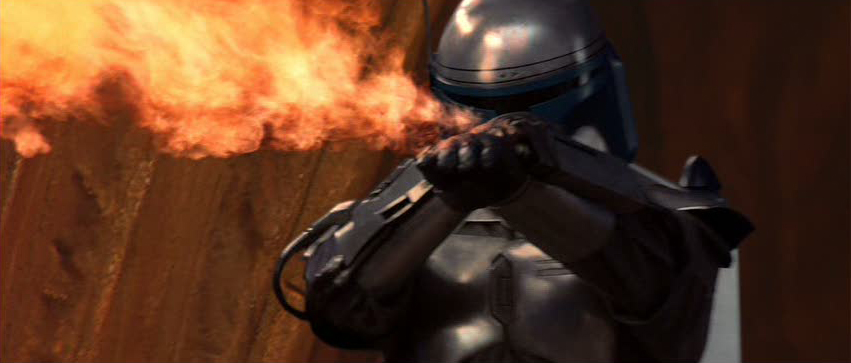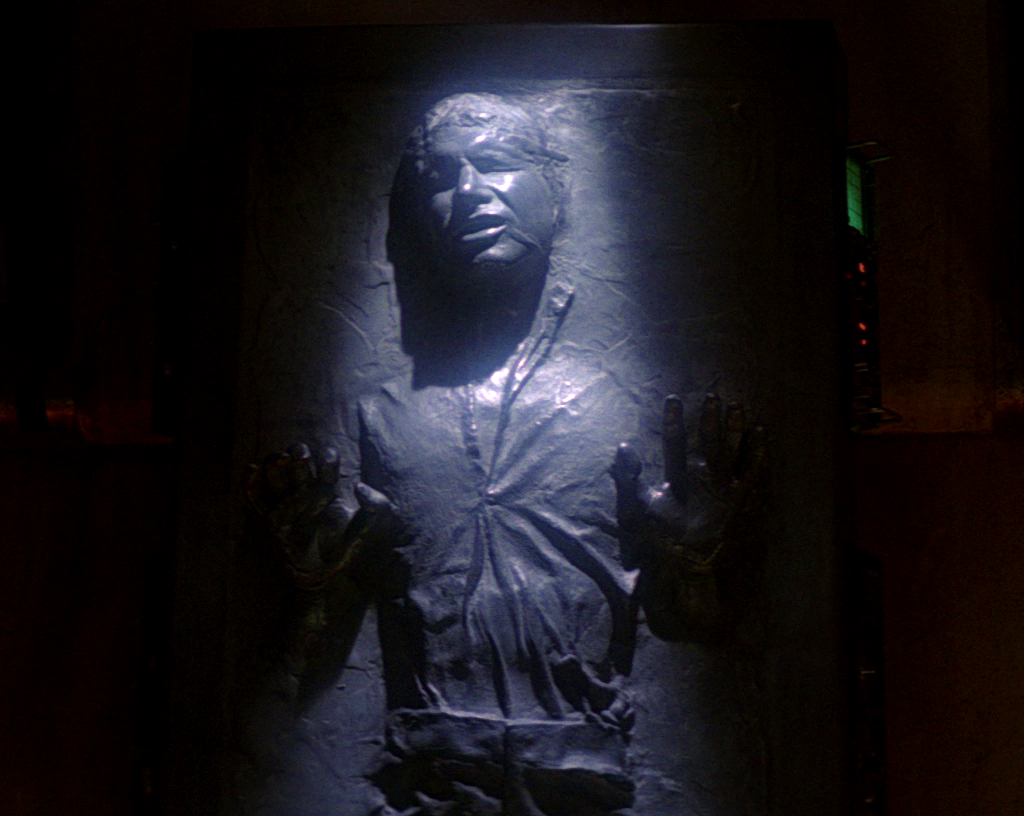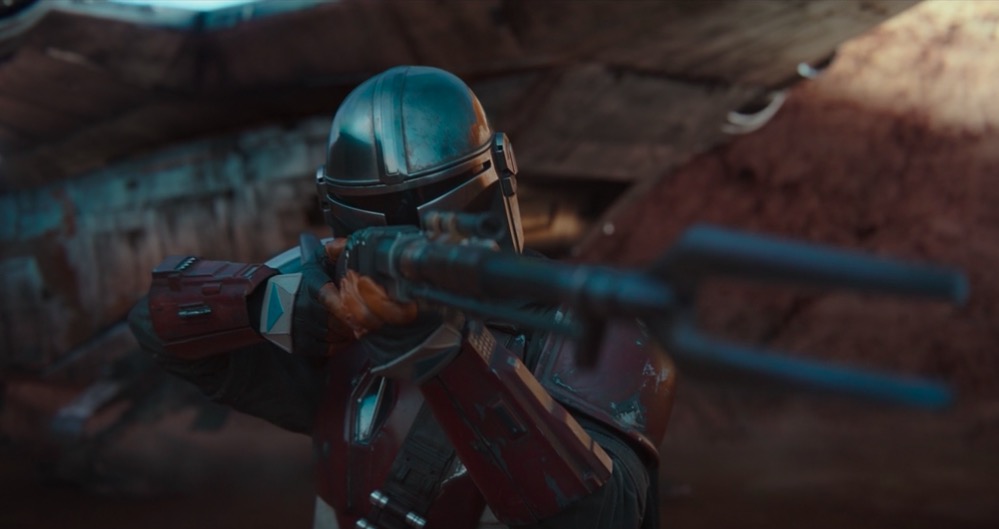
@offthegeekend
Of the many panels that were available for viewing during SDCC@Home 2020, one touched upon a new favorite bounty hunter in a galaxy far, far away: The Mandalorian aka Din Djarin. However this panel wasn’t about the series as a whole, or a preview of the upcoming Season 2, but rather a look into his gadgets. Brought to us by podcast team FGGGBT or “Fascinating Gadgets, Gizmos & Gear-based Tech”, The Brain Trust team features Daniel J. Glenn, Dr. Michael Dennin and Ben Siepser.
Using real world, modern day technology and science, this group came together to theorize the inner-workings of his assorted tools. The group was pretty high energy and had a good grasp of the topic at hand, that being of Mando and Star Wars. Combined with their backgrounds, they were on track to cover all of Djarin’s wonderful toys.
TRACKING #
First up, the panel discusses the tracking fob given to bounty hunters to track their targets. Glenn brings up the fact that we have similar tech, albeit short range, with RFID and chip tracking, but the real question comes with tracking long range across the galaxy. Dennin suggests something along the lines of resonant frequency, in that everything has its own and could be tracked in that manner.
Siepser agrees, but recalls a certain race in Star Trek that actually created a grid of sensors across a portion of their galaxy to track their citizens, and that this could be a similar situation given the Galactic Empire’s aim for control over the galaxy in Star Wars. Perhaps they have sensors or use communication arrays planted all over that are used to coordinate approximate locations for ships and beings. The tough part was explaining how they can be tracked to a pinpointed location, given that they aren’t just walking around with chips implanted, as people would just remove them to not be tracked.
FIRE IN THE SKY
This was followed up by a few well known gadgets and fan favorites. Some of these, such as the jetpack and flamethrower, were a bit easier to explain. With the ‘pack, Glenn points out that this is an actual existing gizmo that has been researched and tested for decades, and recently there was a man in Dubai that did just this. His usable pack isn’t compact like the Mandalorian’s, but it’s proof of product.
Flamethrowers have also existed for a long time, but the trick here was explaining the size and containment of propellant. Siepser mentions that napalm was used as an example of such existing technology, but it was pointed out that it’s less of a fire being thrown and more of a substance that is spewed and lit on fire: gelified gasoline which requires a tank or container. Oddly none of them remembered that both Boba and Jango Fett (sharing the same armor) had this same device which had visible lines run from the gauntlet to the back pack. Mando’s might be more contained, yet I think the answer is a shared propellant in the backpack.
Mini-rockets is another that is a bit more explainable in propelling the “rockets”, and the lethality is a bit harder given their size. Dennin points out how technology is getting smaller and smaller, suggesting existing explosives or lethal projectiles could be made small enough to bring reason to this tech. Of these four classics, carbon-freezing was the one most thoroughly discussed. The name itself suggests being frozen, and was sort of backed up by Han being visibly cold when coming out of the carbon-freezing chamber in Return of the Jedi. The trio kept along these lines and looked into existing science for explanation.
First we’ll get out of the way that they all agreed the carbon coating was a perfect means to restrain the detainee as well as protect them from harm during transport. As does happen in the real world, handcuffs and similar restraints only work to a point and sometimes are defeated, allowing the detainee to escape even if momentarily. However, the sleep (or hibernation) process is one that apparently science has already been testing, with scientists looking for a sort of “sleep” button that can trigger hibernation in creatures that normally do not hibernate at all. They have found they are able to trigger this and actually caused rats to sort of hibernate.
Next up was explaining the freezing process. Dennin points out that while freezing isn’t touch, the trick was to not burst the cells during the process. Siepser follows by mentioning flash-freezing, possibly using something like liquid nitrogen. The group goes back and forth a few times with this, ultimately agreeing that this would be very tough to actually make happen without hurting the being inside.
Further devices included the Amban Sniper Rifle, which has a disintegration outcome from its projectiles. Denning suggests resonant frequency again (which seems to be his favorite go-to, and is brought up with pretty much every gadget discussed), using this to disperse the molecules enough to break their bonds. Siepser agrees, but focuses on the energy required to make this happen, noting that we can see the Mandalorian actually use a cartridge to supply ammunition for this weapon. He suggests the Amban possibly being plasma-based.
Another was the magnetic bombs that the bounty hunter uses to attach to a surface and blow it up. The group discusses not only the method of attachment, pointing out that it can’t be magnetic since it sticks to non-magnetic surfaces, but also looks into the ability to cause such an explosion. They toss around the points of stabilizing the chemicals and having an activating agent to set them off, and how TNT in the old western days was very unstable; yet, they never come up with something in modern day technology to explain it, as the size is too small to contain enough to cause the explosions seen in the show and movies.
And of course they come around to his choice of coverings, the beskar armor plating. The discussion here revolves around its protective properties and value. Dennin mentions.. resonant frequencies, and notes that he regrets not mentioning it during the carbon freezing. The point: metal reflects light because of the wavelengths, suggesting the resonant frequency would be why it deflects blaster bolts. While Siepser agrees that beskar has some sort of resonant affect, he points out that we eventually see some sort of electronics underneath the armor, which could be used to amplify the metal’s properties and provide a sort of shielding, similar to electromagnets and magnetic fields. They discuss the ability to “tune” this ability in the metal, and that the metal itself has its own inherent properties. This is why beskar’s still valuable even without such gadgetry to enhance it.
The Brain Trust wrap things up, acknowledging the challenges of Mando’s amazing equipment existing in the modern day real world. Here are their fav tools from the show:
-
- Dennin was up first mentioning Baby Yoda’s floating cradle (how as this not discussed?)
- Siepser follows up with IG-11, the assassin droid that becomes a protector for said child.
- Glenn closes with his choice being the flamethrower, which is notably a fan favorite for years since we first saw Boba Fett.
For the most part I enjoyed this panel, although I think it helps being a huge fan of Star Wars. The group does a decent job of passing the topic around and getting everyone’s take and opinion. I also love the idea of looking into how things are made and work, so that made the watch easier. That said I did wish they placed everyone in a 3-picture gallery view, rather than jumping back and forth between speakers. Unfortunately this looks to be how they do all their pandemic-stricken videos. 3.25/5 Bibles.
-Patrick Obloy
For anyone interested in these sort of discussions, you can find the FGGGBT shows here. They do these Zooms on a regular basis, many times at conventions in their own panel such as this one, and discuss all sorts of topics to explain the inner workings of things from movies and comic books. This should make Episode 52, with their last one being about Star Trek Voyager.






